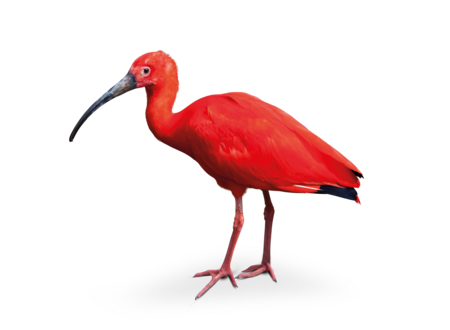Scarlet Ibis
Eudocimus ruber
![[Translate to English:] The picture shows a portrait of a Scarlet Ibis. The bird has a long beak and bright red plumage.](/fileadmin/_processed_/8/8/csm_roter-sichler-hellabrunn-tierpark-welt-der-voegel_0a2f480254.jpg)
- FamilyIbisse und Löffler (Threskiornithidae)
- Weight500 – 700 g
- HabitatWetlands such as mangrove forests and marshes
How does it get its colour?
The scarlet ibis is born with brown plumage, which it keeps for the first 6 months. Only then will the bird slowly begin to develop its namesake scarlet feathers. The scarlet colouration that appears as it grows is due to a diet of red crustaceans: pigments from the shells of various crustaceans are stored in the feathers, thus producing the brilliant scarlet colouration. At first glance, the scarlet ibis appears completely red, however it also has a few black feathers on its wing tips. These are mainly seen in flight.

Blind foraging
Like the glossy ibis, the long curved bill is adapted for foraging in shallow water. The scarlet ibis belongs to a group of ibis that rely on their sense of touch to search for food. It uses its bill to probe the mud until a potential prey such as a crab or beetle is felt by its tactile cells. These cells sit under the keratin layer of the bill and trigger a snapping reflex.
Scarlet ibis often live in large colonies. But there is hardly any chattering there as the scarlet ibis is a very silent bird.
Distribution
